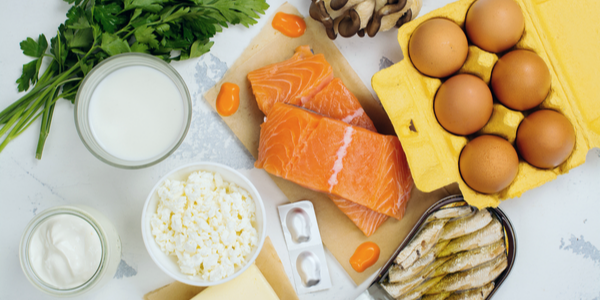
Vitamin D is one of the most important yet misunderstood vitamins of them all. For one, vitamin D is actually a hormone and different forms of vitamin D are more absorbable and functional within the body. And because vitamin D adequacy or deficiency correlates with health status and disease risk, it is vital to optimize vitamin D status.
Thus, absorb this guide to learn the differences between vitamin D and D3, vitamin D-rich foods, the best vitamin D supplements, and more!
What Is Vitamin D?
As mentioned, vitamin D, also called calciferol, is a steroid hormone that is also considered a fat-soluble vitamin. The other fat-soluble vitamins are A, E, and K, and all of them are stored with fat tissue whereas water-soluble vitamins like C are excreted through the urine.
When skin is exposed to the sun, the body produces vitamin D from cholesterol. This is why it is often called the sunshine vitamin, though sun exposure rarely provides enough.
Many people need to obtain additional vitamin D from food. Unfortunately, very few foods are good sources of vitamin D, making supplementation necessary for many people.
Vitamin D Versus D3 and Health Benefits
To further highlight the conundrum of vitamin D, this hormone requires two conversions before it morphs into its active form. This is where the difference in forms of vitamin plays a role and these conversions are absolutely necessary to activate regular vitamin D (calcidiol) into vitamin D2 (calcitriol) in the liver and finally vitamin D3 (cholecalciferol) in the kidneys and gut to some extent.
Furthermore, D3 supplements are two to three times better at replenishing vitamin D status than D2, highlighting the bioavailability of the active form compared to the other nonactive forms.
The active form of vitamin D3 acts as a hormone and can interact with nearly every cell in the body via the VDR receptor. When D3 binds to this receptor, it turns genes off or on, which has implications for disease risk, immune function, and overall health status.
It is well known that D3 affects many cells related to strong bone health (reduced risk of osteoporosis) as it increases absorption of calcium and phosphorus from the gut. However, newer research links D3 status to everything from cancer to diabetes to obesity and the ability to fight off viruses.
The main health benefits associated with adequate vitamin D absorption include:
• Good bone health/reduced risk of osteoporosis, falls, and fractures
• Increased muscular strength
• Decreased risk of cancer
• Reduced depression, anxiety, and better mood regulation
• Decreased risk of metabolic syndrome, diabetes, and obesity
• Reduced autoimmune activity
• Improved immune system function
• Decreased systemic inflammation
• Reduced risk of neurological disease (Alzheimer's, Parkinson's)
• Longer lifespan
Vitamin D Deficiency
Known as Rickett's in the most severe cases, vitamin D deficiency is actually very common in the United States. However, some people are at greater risk including the elderly, those with lactose intolerance or fish allergies, and those who live in areas that do not receive as much sunlight (like Minnesota, Alaska, Canada, etc.).
Other groups at higher risk are Hispanics, African Americans, those with cardiovascular complications, and children in underdeveloped countries. Nonetheless, it is estimated that 40-90% of Americans are vitamin D deficient!
Unfortunately, vitamin D deficiency does not lead to immediate, obvious symptoms and may go undetected for years. In fact, most people only discover they are vitamin D deficient after getting blood tests related to another illness or health complication. This also means that there are not any major obvious or even typical symptoms.
Thankfully, the worst form of deficiency – Rickett's – has largely been eliminated in Western countries thanks to the fortification of breads, cereals, and milks. However, Ricketts remains a major problem in underdeveloped countries and results in deformed bones, the most obvious being bowed legs.
How Much Vitamin D Do You Need?
The recommended dietary intake (RDI) for vitamin D depends on age and pregnancy status:
Age/Group
RDI
0-12 months
400 IU
1-70 years
600 IU
Adults >70 years and pregnant or breastfeeding women
800 IU
However, there is much controversy over whether these recommended IU amounts are actually sufficient. Similarly, a blood level of 20 ng/mL is currently considered adequate. But ample research shows that a truly adequate blood level is at least 30 ng/mL and likely even closer to 50 ng/mL or more.
Thus, a safe upper limit of vitamin D is 4000 IU, over triple the current recommendations. Most likely, it is wise to consume 1000-2000 IUs of vitamin D per day from food and supplementation.
How to Get Enough Vitamin D
There are three main ways to obtain enough vitamin D, and it usually requires a combination of at least two of these techniques and often three. While food is always the first recommendation, if you do not eat fatty fish like salmon and sardines, supplementation is almost always necessary.
Obtain Sunlight
Regularly obtaining enough sunlight is an excellent way to optimize vitamin D status because UVB rays from the sun help produce vitamin D from the cholesterol in your skin. However, there are some interesting stipulations.
Number one, this mechanism does not work if wearing sunscreen. Thus, getting 10-15 minutes of sunshine without sunscreen per day is recommended In the warmer months, it is best to do this earlier in the morning or closer to sunset to prevent bad burns that harm the skin. Glass windows also prevent this production so staring out a window is not viable.
Number two, consistency is key. It is much better to consume a little bit of sunlight every day rather than try and get it within a seven-day period once or twice a year on vacation. The risk of vitamin D deficiency is still high in this latter scenario. Moreover, as vitamin D gets adequately stored in the body, people typically require less sunlight to achieve adequacy.
Number three, those who live in areas without enough regular sunshine should almost always supplement with D3. The sun literally needs to be potent enough for this production to occur, and there are some Northern areas (especially Alaska) that simply will not cut it!
Increase Vitamin D-Rich Foods
As mentioned before, not many foods - whether animal sources or plant-based - boast high levels of vitamin D, let alone the active D3 form. Truly, the only exemplary source of vitamin D is fish cod liver oil. In fact, the second-best source, salmon, would need to be consumed nearly every day to obtain enough vitamin D.
In addition, some milks, breads, and cereals are fortified with vitamin D and some rare types of mushrooms and egg yolks contain small amount. However, it is hardly enough to ensure adequate amounts of vitamin D.
The highest (and only sources) of vitamin D include:
• Cod liver oil (D3)
• Salmon (D3)
• Tuna (D3)
• Beef liver (D3)
• Whole eggs (organic, pasture-raised) (D3)
• Sardines (D3)
• Fortified foods and orange juice (D2)
• Rare mushrooms (D2)
Supplement as Needed
Undoubtedly, D3 supplements are more effective at correcting deficiencies or maintaining sufficient vitamin D. D3 is not only absorbed better, but D2 is more sensitive to heat and humidity, rendering this latter form useless if stored improperly. Finally, research shows that D3 supplements are more than twice as effective at raising actual blood levels of vitamin D.
In general, a good vitamin D supplement should:
• Have an effective dose (1000 IUs or more)
• Be in the form of D3
• Have the ability to be stored at room temperature
• Be third-party tested and free of unnecessary fillers and additive
• Possibly include other fat-soluble vitamins (A, E, and especially K) and/or omega-3 fatty acids if not taking these identified nutrients elsewhere
According to Healthline, reputable brands with effective vitamin D supplement choices include:
• Pure Encapsulations
• NOWFoods
• Nordic Naturals
• Thorne
• Designs For Health
Finally, supplementing with cod liver oil typically ensures vitamin D adequacy as well and would not need to be taken in addition to an isolated form of vitamin D. Plus, cod liver oils sometimes include fat-soluble vitamins like D and K.
The Bottom Line
Vitamin D is a very potent and interesting group of substances that actually behave as hormones and turn certain genes off or on. Thus, the adequacy of vitamin D is vital because it is associated with so many diseases and health outcomes.
Of the three forms, D3 is undoubtedly the most bioactive and therefore useful. While the RDI currently sits around 400-800 IU/day, a more optimized goal is closer to 1000-4000 IU/day. Some people can obtain enough D3 through sunlight, but most people require a combination of sunlight, food, and supplementation.
Certain groups of people will always need D3 supplementation and it is most important to look for reputable brands with high-quality doses and ingredients or lack thereof.
References:
Arnarson A. Vitamin D2 vs. D3: What's the Difference? Healthline. Written March 4, 2018. https://www.healthline.com/nutrition/vitamin-d2-vs-d3#TOC_TITLE_HDR_4.
Gunnars K. Vitamin D 101 - A Detailed Beginner's Guide. Healthline. Written March 6, 2019. https://www.healthline.com/nutrition/vitamin-d-101#intro.
How to Get More Vitamin D from Your Food. Cleveland Clinic. Published October 23, 2019. https://health.clevelandclinic.org/how-to-get-more-vitamin-d-from-your-food/.






